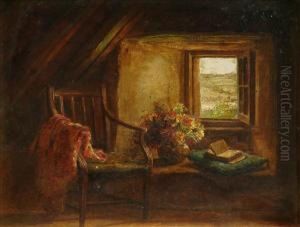Catherine Mary Wood Paintings
Catherine Mary Wood was an English painter born in 1818, during a period when the art world was predominantly male-dominated. Despite the challenges faced by women in the arts during the 19th century, Wood managed to carve out a space for herself as a painter, primarily focusing on landscape and figurative subjects. Her life and career offer a glimpse into the struggles and achievements of female artists in Victorian England.
Wood's artistic journey began at a young age, encouraged by a burgeoning interest in the natural world and the human condition. Though detailed records of her education and training are scarce, it is believed that she was largely self-taught, with perhaps some informal guidance from male contemporaries or local artists. This was a common path for many women artists at the time, as formal art education and professional opportunities were largely inaccessible to them.
Throughout her brief career, Wood's work was characterized by a delicate sensitivity to light and color, which she employed to great effect in her landscapes. Her figurative works, on the other hand, often explored themes of femininity and domesticity, reflecting the limited sphere within which women's lives were confined. Despite these constraints, Wood's paintings exhibited a depth of emotional expression and technical skill that gained her a modest but dedicated following.
Wood's contributions to the art world were cut short by her untimely death in 1845, at the age of 27. Though she did not live to see the broader changes that would eventually afford women greater access to the art world, her work remains a testament to the talent and perseverance of female artists in the face of societal obstacles. Today, Catherine Mary Wood is remembered not only for her artistic achievements but also as a pioneer who paved the way for future generations of women in art.

















